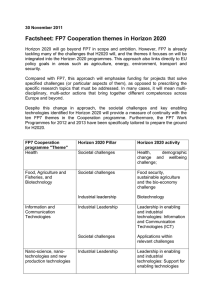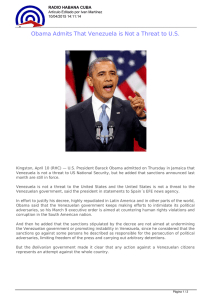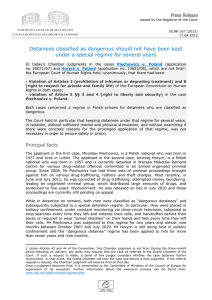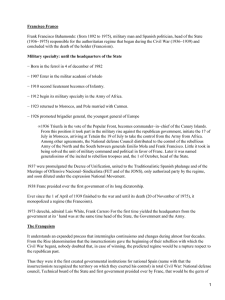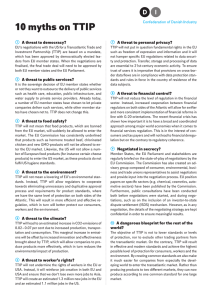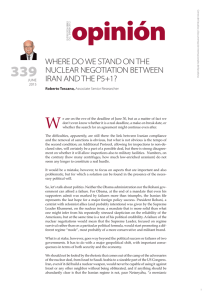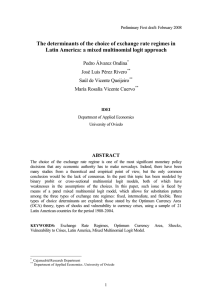RECOMMENDATIONS FOR IMPROVING BIOSECURITY MEASURES
Anuncio
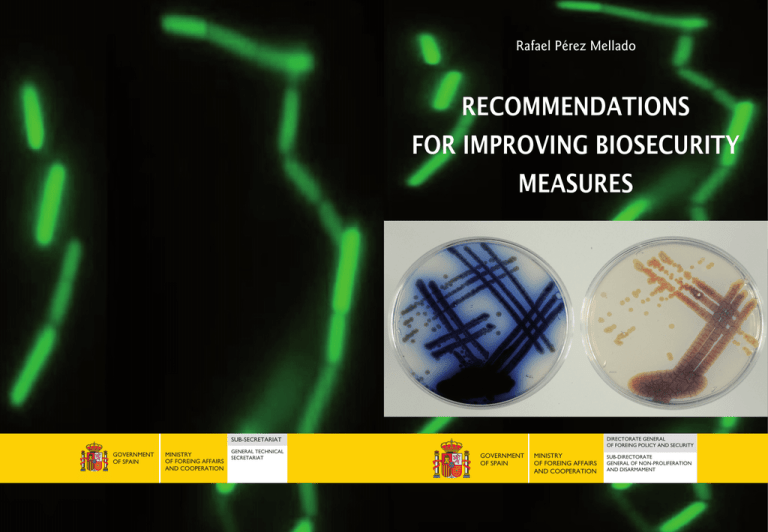
Rafael Pérez Mellado Recommendations for improving Biosecurity measures DIRECTORATE GENERAL OF FOREING POLICY AND SECURITY SUB-SECRETARIAT GOVERNMENT OF SPAIN MINISTRY OF FOREING AFFAIRS AND COOPERATION GENERAL TECHNICAL SECRETARIAT GOVERNMENT OF SPAIN MINISTRY OF FOREING AFFAIRS AND COOPERATION SUB-DIRECTORATE GENERAL OF NON-PROLIFERATION AND DISARMAMENT —1— —2— Rafael Pérez Mellado RECOMMENDATIONS FOR IMPROVING BIOSECURITY MEAsURES Government of Spain Ministry of Foreign Affairs and Cooperation Directorate General of Foreign Policy and Security Sub-directorate General of Non- proliferation and Disarmament —3— Author: Rafael Pérez Mellado Scientific Adviser Non-proliferation of biological agents Background of front page cover and inside cover: Genetically modified Bacillus subtilis bacterium for the overproduction of a green fluorescent protein viewed under fluorescence microscopy. Superimposed cover: Culture in solid medium of genetically modified Streptomyces coelicolor bacterium for the overproduction of an antibiotic pigmented in blue, compared to the non-producer bacterium. Photographs provided by the author for their reproduction. The images cannot be reproduced without the author's permission. MINISTRY OF FOREIGN AFFAIRS AND COOPERATION Sub-secretariat General Technical Secretariat General Technical Vice-secretariat Documentation and Publication Section NIPO, edición impresa: 501-15-038-0 NIPO edición en línea: 501-15-039-6 Legal deposit n.º: M-26330-2015 Printed by the Office Of Diplomatic Information —4— ÍNDex Páge Introduction .................................................................................. 7 Objectives of a biosecurity system on a national level ............. 8 Elements of a National Biosecurity Regime for facilities and associated activities.................................................................. 9 Recommendations for elaborating a national strategy to combat potential biological attacks .............................................. 11 1. Prevention of a potential biological attack...................... 11 2. Evaluation of the risk and threat of a biological attack.. 12 3. Preventive measures to counteract a biological attack.. 17 Recommendations for the biosecurity of materials and biological agents and the activities associated with them and the biological facilities ............................................................. 19 1. General recommendations ............................................... 19 2. Recommendations to implement and/or reinforce biosecurity in biological facilities ....................................... 20 3. Recommendations to implement and/or reinforce the biosecurity of materials and biological agents transported in national territory............................................... 23 4. Recommendations to implement an/or reinforce biosecurity during the importation of biological materials and agents ........................................................................... 26 Definitions....................................................................................... 27 —5— —6— INTRODUCTION The international community resolved to completely exclude the possibility of using bacteriological and toxin agents as weapons passed the “Convention on the prohibition of developing, producing and stockpiling bacteriological (biological) and toxin weapons, and their destruction”, compiled in London, Moscow and Washington on April 10, 1972. On these same lines, the United Nations Security Council voicing its concern with the threat of terrorism and the risk of non-state agents acquiring, developing and employing nuclear, chemical and biological weapons or trafficking with them adopted Resolution 1540 of April 28, 2004. The Organisation for Security and Cooperation in Europe (OSCE) in its meeting of July 21, 2010, adopted a series of Recommendations exhorting the development of national plans to improve the application of Resolution 1540, including the prevention of biological weapons. Within the framework of the European Union, the European Council of 2008 approved some Conclusions on the “New lines of activity in the fight against the proliferation of Weapons of Mass Destruction (WMD, nuclear, radiological, chemical and biological) and their vectors”. Each Member State of the European Union is committed to adopting measures tending to totally exclude the possibility of biological agents being used as weapons. Each sovereign State is responsible for maintaining its national security as concerns biological material (biosecurity). In particular, to strengthen security in all matters related to biological materials and agents, as well as facilities and associated activities to assure the cus—7— tody of these materials and agents, their stockpiling and transport, and to combat illicit trafficking of these materials and agents, as well as endeavour to be prepared for an eventual response to a biological attack, be it natural, intentional, or accidental. The establishment of a “National Biosecurity Regime” comprises the development of all those measures that may facilitate a real custody of relevant biological agents which consists of controlling any physical access to them and the physical protection of the facilities where these agents are handled. These “Recommendations” endeavour to be of use for the elaboration of the appropriate biosecurity measures which may be applied in the handling of biological materials and agents in the corresponding facilities and during the activities associated to this handling. OBJECTIVES OF A BIOSECURITY REGIME ON A NATIONAL LEVEL The global objective of a biosecurity regime on a national level consists of the protection of persons, properties and facilities, the environment and society in general from any illicit acts which may occur by means of the use of biological weapons or agents, with unacceptable and even irreparable biological consequences. Therefore, herewith is a list of the objectives of a biosecurity regime on a national level: 1.To protect against the theft of any relevant biological agents and materials handled in the corresponding facilities where they are kept and any illicit activities associated with them. 2.To protect against the sabotage of biological agents and materials, of the facilities sheltering them and any lawful activities associated with them. 3.To assure the implementation of swift, effective and comprehensive measures that permit and ensure the necessary protection. This global objective should be assured by means of security (biosecurity) measures which would deter, detect, delay and respond to any potential illicit acts consisting of the use of biological agents. —8— These biosecurity measures should be based on the principles of prevention, however, not precluding that elements of preparedness and reaction may be considered which, in addition to other more specific ones, should form part of a plan against threats of a biological nature that would assure an in-depth defence of a potentially affected society in the event of a natural, accidental or deliberate biological incident. ELEMENTS OF A NATIONAL BIOSECURITY REGIME FOR FACILITIES AND ASSOCIATED ACTIVITIES 1.The responsibility of establishing biosecurity measures on a national level lies with each sovereign State. 2. The State should clearly define and assign responsibilities to the competent authorities within its national territory as well as territories under its jurisdiction and control, which would also include a corresponding update of legislation, governmental or local agencies with competences in customs and border controls, state intelligence and security agencies, as well as governmental or local agencies with competences on human and animal health, environmental competences and competences in scientific research, etc. Everything would be integrated and coordinated within a Biosecurity Regime on a national level that should depend on committees coordinating activities between the different competent authorities. 3.The State should guarantee an effective cooperation among the competent authorities, including the efficient channelling of any relevant information (e.g. information on the degree of threat of a potential attack of a biological nature or other relevant information) in accordance with national regulations protecting the use of that kind of information, allegedly of a confidential nature. 4. The State should establish and maintain a competent legislative structure to regulate biosecurity for facilities and associated activities on a national level with a view to the following: (a) The risk of illicit acts with biological agents which can have undesirable biological consequences. —9— (b) To unequivocally define the biological agents, facilities and associated activities subject to a biosecurity regime, that in terms of quality and quantity, may classify the potential danger of their natural, accidental or intentional liberation. (c)To create, if this were non-existent, and assign government responsibilities to relevant entities, including an independent regulating entity, if this were necessary. (d) To determine the responsibilities of the organisations commissioned to transport these biological agents in national territory, as well as the facilities that use them and the personnel working with them, so as to devise and apply measures of effective biosecurity in all cases. (e)To establish a biosecurity clearance process for the cases considered in (d). (f)To establish a system of compulsory inspections for regulations and existing or newly passed legislation. (g)To establish sanctions in all those cases where legislation is contravened. (h)To maintain an adequate balance between biosafety and biosecurity. — 10 — RECOMMENDATIONS FOR ELABORATING A NATIONAL STRATEGY TO COMBAT POTENTIAL BIOLOGICAL ATTACKS Any plan to combat potential biological attacks should contemplate three main phases: ―Prevention ―Preparedness ―Reaction The result of the study on prevention should deliver the necessary elements to form part of the design of an adequate preparedness programme to minimise the potential consequences of a biological attack and, once these possible effects have been determined, an adequate reaction programme should be foreseen to counteract them. A biosecurity regime is, by definition, an essential factor for the prevention of a biological attack or incident, even be it natural or accidental. The study on the prevention of biological incidents developed below refers basically to biological threats; however, it is perfectly applicable and equally valid in the case of natural or accidental episodes. 1. Prevention of a potential biological attack 1.1 As a first approach, prevention should be based on studies of risk evaluation and possible threat evaluation, which in theory should consist of prediction-oriented studies, that is to say, they should evaluate the possibility of a potential biological attack event, analysing the nature of the actors/potential perpetrators and the type of weapon or lethal agent they could use. The best means to avoid a terrorist attack or to mitigate the possible impact of such an act is to have an adequate and effective prevention method of such a contingency in place. 1.2There are numerous elements which should be considered when evaluating the probability that an attack with a biological agent would be the type of action chosen by the perpetrators. In principle, the main factors that could influence the biological agent of choice are: ease of access and use, cost (economic, need for infrastructures, etc.) and the scale of the damage caused. — 11 — 1.3The biological agents seem to adjust to these elements of choice due to the ease of access (they are infectious agents existing in nature), the growth/culture of many of them does not require very sophisticated scientific knowledge (this can be acquired in secondary school studies and/or from technical personnel in laboratories), the cost of many of them can be minimised and the extent of the damage inflicted can be considerable, since they have the capacity to cause different levels of incapacity in affected humans and can even be lethal, depending on the agent used. 1.4 In any case, an effective study of prevention should not be based on premises relating to a greater or smaller theoretic possibility of using one or another type of weapon or agent by alleged perpetrators, rather to the contrary, it should consider that the attack, using the agent or weapon for which the study has been conducted, will occur in all likelihood and, based on this, evaluate an adequate prevention plan. 2. Evaluation of the risk and threat of a biological attack The evaluation of the risk consists of three kinds of different analyses: (a) evaluation of the magnitude (b) evaluation of the effect (c) evaluation of the vulnerability The evaluations of the magnitude and effect of the possible biological attack are going to lay the foundations in unison for a proper evaluation of vulnerability. 2.1. Risk and Threat If there are alleged aggressors, the risk of an attack always exists, at least potentially. A threat would be a worsening of the risk situation. To correctly evaluate the risk of a biological attack, the possible group or groups of aggressors who may perpetrate that attack must be identified, and their ideological foundation or motivation (political, religious, etc.) as well as their demands/vindictive claims, and how these can influence — 12 — the choice of a certain type of biological agent as regards the extent of the damage they intend to cause. For a realistic evaluation of the risk, the alleged aggressors must be such that, by its nature, would have or could acquire the capacity to launch this kind of attack. To determine this, a thorough study of known skills needs to be conducted, that is to say, an evaluation of the operational practices of known groups of aggressors, the resources at their disposal, the degree of sophistication of their organisation and its development over time, its capacity for operational planning and possible targets for attacks. The evolution of risk to a threatening situation is an analysis that has to be done on the basis of information acquired, and the subsequent threat rating would lead to the activation of the corresponding prevention, preparedness and reaction measures already in place or designed beforehand for this circumstance. 2.2. Effect An assessment of the effect will depend on the realistic evaluation of the damage capability the different biological or toxin agents may have, their possible target (humans, animals, plants) and the susceptibility of society to that possible damage (human or animal health, damage to agriculture, any additional consequences etc.). In general terms, the terrorists will tend to harm whatever society is inclined to protect more, or for which it has a greater level of sensitivity. The assessment can be affected by the fact that the possible targets of the aggressors may be institutional services or infrastructures whose paralysation would imply an impact on society in general, and moreover, the target of the perpetrators may be direct or indirect, by affecting the economy or by trying to impose decisions of a political nature. A proper evaluation of the societal impact a biological attack may exert, although there may be a mean primary target, implies the consideration of secondary and even tertiary side effects which, in a domino effect, aggravating the primary damage caused. Hence, these second- or third-order effects should form part of the assessment of the actual magnitude of the impact of the attack. — 13 — 2.3. Vulnerability Vulnerability is the susceptibility of society to a threat. The level of vulnerability will depend on the magnitude of the societal or economic damage that the potential attack would cause. In turn, the extent of the damage is directly dependent on the quantity and quality of the damaged structures, that is, the actual consequence of the attack. When determining vulnerability one cannot forget the impact that hoaxes may exert on the population. The more exact can be the estimation of the vulnerability, more efficient measures can be designed to counter the biological attack. 2.4. The societal model and biological attack Biological attacks are generally focused on causing harm to society, primarily to the citizens and direct or indirectly to the political life of a country. The impact of a biological attack depends on what happens during and after that attack since, regardless of the primary target of the attack, this is going to influence, to a greater or smaller extent, the overall functioning of society, and direct or indirectly, this will be reflected in the normal running of politics in the affected country. This should always be considered when conducting a vulnerability study. For the purposes of determining the vulnerability of a society, this can be visualised as a set of three groups: the citizens, the institutions directly responsible for societal services and higher level institutions that ensure the political, societal and economic stability of a country In this model any incidence affecting a set of citizens will exert a derivative effect on the corresponding societal services and, depending on the relative extent of that effect, higher level institutions will be affected. Hence, on a first level, a biological attack will basically have an impact on the health of the human beings under attack, on a second level the corresponding societal services will be affected, and lastly it will exert an impact on the political stability and viability of a nation. Eventually, the societal services directly responsible for responding to an emergency situation resulting from an attack of a biological — 14 — kind against humans (police, fire-fighters, emergency medical services) could be included on the first level, depending on the number of persons affected by the attack and the degree of contagion inherent to the biological agent used. The societal services will always be included on the second level since any action significantly affecting the country's health services will have repercussions on the quality of those services. The existence of isolation and quarantine measures that can swiftly be put into place in the affected area will reduce the risk of negative impacts on a second level. Additionally, impacts from the first level can be exerted directly on the third level. For example, if the members of government or the highest ranking dignitary of a nation were infected by a biological agent, this could result in political instability, at least temporarily, or perhaps prompt early elections which could involve a change in the political direction of the nation's government. On evaluating vulnerability in the face of a biological attack these variables ought to be taken into consideration when using the proposed societal model, however, the assessment should not be biased by making a judgement of temporality on the impacts in none of the three levels. The degree of vulnerability needs to be established as a result of the integration of the possible effects on the three levels, in such a way that the corresponding measures that may counteract the attack suffered can be set to work. 2.4.1. Impacts on the first level Human health (the primary target of the attack) is affected; the elements of the emergency services when the targets are human beings are also impaired. The impact of an exposure to a biological agent does not manifest itself immediately. An infection by biological agents usually requires an incubation period which may take some days and even weeks. Therefore, it would be a mistake to consider the impact on the first level as short-term when dealing with a biological attack. The majority of illnesses inflicted by biological agents are contagious, some of them extremely contagious, and as a result, the impact of an attack cannot be restricted to an area defined as the centre of that at— 15 — tack (to those primarily infected), but in all probability will expand, increasing the size of the area which would have to be subjected to the corresponding quarantine. The staff of the emergency services can, in turn, be infected, which would make the magnitude of the effect even greater. A feature of the biological attack is, by definition, its time of detection, favouring its expansion among the population and maximising its effect. This impact has not only a physical component, but it entails psychological consequences among the affected population (poorer health) and the emergency services (some of its components affected, increased work load, saturation of hospitals and clinics, etc.), causing anxiety in the general population due to the evidence of an existing disease that is spreading without actually knowing how it came about, or how and when it will be under control. The alarm produced in the population with regard to the veracity ascribed to a false (hoax) biological attack may be the same as that attributed to an authentic biological attack. 2.4.2. Impacts on a second level The disruption in the emergency services can lead to a higher work load for those who are not affected, and the functions they normally perform as a service to society would be impaired. Depending on the degree of exposure to the agent and its virulence, the general services of a population such as water, gas, and electricity supply, as well as the food distribution chain, etc., can be seriously impaired. Again the presumption of the existence of a biological attack whose falsehood is unknown may directly cause effect s on a second level (depletion of food products, petrol, drugs, etc., being grabbed by the population), affecting the functioning of societal services either directly or indirectly. 2.4.3. Impacts on a third level Certain infrastructures and facilities can be permanently impaired in such a way that the societal rules may be eroded or changed by different ones, which may include, for example, changes in legislation — 16 — to cope with the emergency situation created by the attack (changes that could become permanent), with the consequent impact that this may have on societal freedoms and the economy of the affected population, which eventually, may cause greater political and economic changes. There are no precise rules to determine how these changes may take place as a result of a biological attack, or their relative extent, however, it is easily predictable that to the extent that the civil authorities are able to control the attack, they might or might not maintain their political options in the next elections, or that the possible loss of confidence in the economic institutions nay exert an additional impact in the short, medium or long-term. 3. Preventive measures to counteract a biological attack The measures to counteract a biological or toxin attack should be designed in accordance with the results of the risk evaluation in order to prevent this attack from being carried out and, in the event of it taking place, endeavour a more favourable protection on the three levels that form part of the societal model described above. 3.1. Measures aimed at the perpetrators of a biological attack Measures of an eminently preventive nature should primarily and fundamentally be centred on the alleged perpetrator, his identification, and even more importantly, on the identification of the societal elements or circumstances that can influence a citizen to embrace this type of action on his own, or to join an organisation that is already established and fully operational. Hence, there are two kinds of measures aimed at the perpetrators. These can be considered as “societal prevention measures”, that is to say they need to be designed to prevent society from generating discontent in certain societal groups so as to avoid new potential perpetrators from enlarging the already existing ranks. Among these measures are those addressed to defend the rights of the minorities, both ethnic and marginalised, or those that create development plans especially aimed at social sectors where poverty and the dif— 17 — ficulty of finding a job prevent leading a lifestyle with the same degree of social dignity as other citizens. The next type of measures aimed at terrorists are those that endeavour, once an individual or group of individuals decides to undertake the path of biological attack, to make life more difficult for them to continue on that path, that is, “societal contention measures” that may render it difficult for these individuals to associate, to be trained, to receive funds, to have access to biological agents, etc. 3.2. Measures directed at minimising the impact of a biological attack Measures to minimise the impact of a possible attack with biological or toxin agents should be channelled to hamper that the possible targets of an alleged attack are struck, and simultaneously should endeavour that the necessary resources to minimise the impact of an attack, if this were to occur, are available in sufficient quantity. These “societal protection and contention measures” should also be devised to curb the possible effects of the attack on a first level of the social model and impede their expansion to the other two levels. 3.3. Measures directed at restoring the damage produced by a biological attack These are measures destined to repair the damage produced, to restore the existing situation to one before the onset of the attack and, additionally, if possible, to improve that situation. These “societal repair measures” should be applied specifically for each impact produced by the alleged attack on each and every level of the three levels of the societal model. — 18 — RECOMMENDATIONS FOR THE BIOSECURITY OF MATERIALS AND BIOLOGICAL AGENTS AND OF THE ACTIVITIES ASSOCIATED WITH THEM AND THE BIOLOGICAL FACILITIES 1. General recommendations The biosecurity measures directed at the prevention of illicit acts should be designed to (a) Dissuade these acts. (b) Detect and impede access that is not authorised or the loss or theft of materials and biological agents. (c) Rapidly evaluate the events that could have suggested an irregular situation and/or the disruption of the biosecurity measures in the facility and in handling the materials and biological agents in order to permit a swift reaction to mitigate the corresponding effects. (d) Make a provision of the elements that may allow a swift response in the event of a disruption of the biosecurity measures. 1.1. The correct design of a National Biosecurity Regime requires the creation of a kind of legal authority (from now, National Competent Authority for Biosecurity NCAB) which would regulate, control, coordinate and standardise the necessary biosecurity measures everywhere in the national territory and in territories under the jurisdiction and control of the State. All the Ministries with competences in the field of biological agents and their custody should be represented in NCAB. 1.2. Biological and toxin agents and associated material of dual use must be subject to export control and therefore correctly inventoried. Mechanisms will be established which will permit the NCAB exerting tutelage and control over tangible and intangible transfers of technology without depleting a desirable scientific and technological development. 1.3. A mechanism will be established which would permit NCAB to supervise the potential dual use of advances in scientific and techno— 19 — logical research to impede a possible use of illicit intentions as well as a potential transfer of intangible materials. 2. Recommendations to implement and/or reinforce biosecurity in biological facilities 2.1 The biological facilities included in the field of application of these recommendations should have available a system of biosecurity which, considering the update on the evaluation of the threat, accessibility to biological agents and materials of a potential adversary, the nature of these and the foreseeable consequences derived from their theft or acts of sabotage, should develop the general measures established in the following paragraphs. 2.2 The biological facilities should have available a Department or Committee of Biosecurity led by a person Responsible for Biosecurity, who will be in charge of the physical or electronic measures to be adopted, as well as the biosecurity services established, in accordance with the legislation in force on private security. The person Responsible for the Biosecurity of the facility should be empowered by the competent authority, in accordance with the legislation in force on private security. The security companies which will be commissioned the task of protecting or supervising the facility will also have to be duly empowered by that authority. This authority should also empower the holders or those in charge who should constitute a Department or Biosecurity Committee, headed by the person Responsible for Biosecurity already mentioned. 2.3The biological facilities should have a biosecurity system guaranteeing the existence of: (a) Protection elements which would dissuade a possible attacker from materialising the threats against the facility. (b) All the necessary organisational, human, technical and material means which are compatible with the normal development of the facility operation, to counteract the threat. (c) The personnel, technical means or a combination of both, which serve to quickly detect any attempt of intrusion in the facility's — 20 — security areas, and moreover evaluate the conditions, circumstances and capacities with which the attempted intrusion is happening. (d) Physical barriers and repeated access controls that would delay the entrance of unauthorised persons and vehicles to protected areas preventing accessibility to vital zones or where the materials or biological agents are stockpiled until the State Security Forces arrive. (e) A supervision service with personnel duly authorised, trained, equipped and structured hierarchically with sufficient and proportioned capacity to prevent the materialisation of the threat until the State Security Forces arrive. (f) The means and procedures necessary to guarantee that information can be communicated and interchanged with the State Security Forces adequately to coordinate response actions. (g) A Personnel Record at the facility as well as any external personnel who, due to the functions they perform, need to have access to areas of the facility or to sensitive information as regards biosecurity, hence the person responsible for the facility is obliged to maintain it updated and to inform the NCAB beforehand of any inscription or withdrawal in the Personnel Record, so that the necessary verifications can be made as regards the objectives of biosecurity of the materials or biological agents and the facility. The personnel who appear in the Personnel Record must be authorised by the competent authority as regards national security. (h) Contingency and emergency plans to respond to the unauthorised withdrawal or sabotage of materials or biological agents in biological facilities. (i) Means of protection and compliance to confidentiality criteria of all information related to the biosecurity of the materials or biological agents and of the facility. (j) Indicators that may assure the establishment of adequate physical security in the facility. — 21 — (k) The establishment and application of an education programme and continued training of the staff organising the biosecurity of the facility. (l) Explicit clearance from the NCAB, to ensure that the biosecurity measures put into effect by the facility are adequate. 2.4 The holder of a biosecurity clearance or operational clearance of a biological facility should establish the necessary procedures which would assure that: (a) All movements of materials and biological agents within the facility are registered with precision, as well as their entries y exits and their localisation, use, movement and transformation, in addition to the date and origin and destination of those that enter and leave the facility. (b) Periodically the physical circumstance of the materials and biological agents is verified with the facility's accounts and, in the event of any accounting anomalies the NCAB will be informed immediately. (c) The NCAB may require that a physical inventory of all the materials and biological agents at the facility is conducted at any moment to compare it with the corresponding accounting records. 2.5The NCAB may address to one or various biological facilities specific technical or administrative instructions on biosecurity which would complement or develop the established general measures. 2.6In situations where the NCAB may determine the existence of a considerable increase in the level of threat or perception of risk, it can require from the holders by means of the emission of the corresponding instructions, the implementation of urgent and special biosecurity measures which would supersede the ones established at that time, with the objective of tackling the situation immediately and during a period of time to be determined, remaining permanently established if this is deemed necessary. — 22 — 3. Recommendations to implement and/or reinforce the biosecurity of materials and biological agents transported in national territory. 3.1. The title owner of a company that transports biological materials or agents should obtain a biosecurity clearance from the NCAB, and to this end should apply the necessary measures to: (a) Establish and maintain a Biosecurity Department headed by a Biosecurity Director, who will be responsible for the physical or electronic measures to be adopted, in addition to the security services established in accordance with the regulation in force on private security. The Director of Biosecurity of the holder's organisation should be empowered by the NCAB in accordance with the legislation in force on security. The security companies that are entrusted the responsibility of protecting and supervising transport should likewise be duly authorised by the NCAB to. (b) Elaborate and apply a biosecurity plan for transporting biological materials and agents in which the human, technical and organisational means would be established to cope with a foreseen threat. (c) Arrange a communication centre to keep a continuous tracking of the transport of biological materials and agents and to communicate with the transport personnel and, in the event of this being available, with the security personnel responsible for the supervision and protection of the transport. (d) Establish communication procedures for the normal development of transport and for anomalous situations or a situation of threat. (e) Establish action procedures for the confirmation of threats, to communicate with the Security Forces and to provide a sufficient delay in the activity of the adversary until these arrive. (f) Notify the NCAB of the date of transport initiation, annexing the following information: — 23 — 1.The holder of the biosecurity clearance for the transport and contact information in the event of an emergency. 2. Foreseen development of the transportation, with initiation and finishing dates, as well as any temporary stockpiling resulting from the transport schedule. 3.Itinerary plan. 4. Identification of the precise moment in which responsibility for the biosecurity of the material is acquired and the moment when this is transferred, identifying the natural or legal persons from which the responsibility of the biosecurity of the material was received or transferred. 5. Classification and description of the materials being transported. 6.Characteristics of the transportation, including number of packages, transport means employed and their identification. 7. Organisation of the transport and identification of participating personnel and of the security personnel responsible for the supervision and protection of the transport, if this were the case. 8. Identification of the drivers and communication means which would facilitate direct contact with them at all stages of the transportation. 9.Any other pertinent information. (g) Maintain a Personnel Record of the organisation staff of the biosecurity clearance holder, as well as the personnel of the companies hired, which, due to their allotted tasks, may need to have access to the transport or sensitive information as regards biosecurity, with the obligation to the holder to maintain it updated and to inform the NCAB beforehand of any inscription or withdrawal, so that the necessary verifications can be conducted with respect to the objectives of physical protection of biological material and its transport. — 24 — (h) Establish emergency and contingency plans to respond to the unauthorised withdrawal or sabotage of biological materials and agents. (i) Notify the persons to whom the biological materials and agents are destined of the transportation starting date and confirm the finalisation date to the shippers. (j) During transportation verify periodically that the physical situation of the biological materials and agents is according to the established transport security plan. (k) Make sure that all the information related to the system of transport biosecurity is conveniently protected and submitted to the criteria set out in paragraph 2.3 (g). (l) Assure, via the establishment of indicators, the introduction of adequate information on physical security. (m) Maintain a minimum of five years the documentation and registry entries relative to all biological materials and agents' transport as well as any reports conducted on his/her own initiative or by request of the NCAB with reference to the causes of any incidents affecting biosecurity that have occurred during transportation, as well as any measures taken in this respect. 3.2. The NCAB can channel to one or various title holders the specific technical or administrative instructions on transport biosecurity which would complement or develop on the general measures previously established for the transport. These new measures will be binding from the moment of their notification to the affected holders. 3.3. In circumstances where the NCAB determines the existence of a considerable increase in the degree of threat or risk perception, the NCAB will oblige the holders, by means of issuing the corresponding instructions, to deploy urgent or special biosecurity measures which would exceed the established general ones or possible complementary ones if that were the case, with the purpose of tackling the situation immediately and for a specific period of time, or until the urgent or special biosecurity measures have been revised in the event that the increase in the degree of threat would be considered permanent. — 25 — 4. Recommendations to implement and/or reinforce biosecurity during the importation and exportation of biological materials and agents. 4.1. The State should adopt the necessary measures, including coordination among importing and exporting States (companies or institutions) prior to their transfer, to minimise the possibility of illicit appropriation of these biological materials and agents in connection with their importation and exportation. These measures should include as a minimum all the requirements relative to the transport of this kind of material in accordance with the Norms of International Transport, including the appropriate type of packaging, the duly visible identification of a hazard etc. 4.2. The NCAB will establish the necessary requirements for the operators, transport companies, consignees, etc., in such a way that they are duly authorised with respect to biosecurity and would have the necessary biosecurity measures established for that clearance in place, and specifically the established procedures of action plans in the event of a threat confirmation, for a communication liaison with the State Security Forces. — 26 — Definitions The terminology used in this publication that needs to be defined (in alphabetical order) Biological Agents: those whose infectious characteristics, virulence and products advise handling in level 3 contention conditions or above, and those that without being assigned to this level of contention (below 3) may be considered by their characteristics and action spectrum as worthy of biosecurity as regards national security. By extension, this definition includes microbial agents and other biological or toxin agents, as well as their vector systems, as convened in article I of the “Convention on the prohibition of the development, production and stockpiling of bacteriological (biological) and weapons, and on their destruction”. Biological facilities: facilities containing biological agents. Biological material: everything that includes biological agents or their components, or is the result of using biological agents for its synthesis or production, or is the result of handling biological agents. Biosafety: technological or operational safety to avoid while handling and transporting biological agents and the products generated by them any damage inflicted on persons, animals, plants, or the environment. Biosecurity: both indoor and outdoor physical protection of the biological facilities containing biological agents and the equipments and materials of these agents, as well as their transport. Intangible materials: those materials whose perception is less obvious, such as technical assistance, training, consulting services, scientific and marketing presentations as well as tangible technical data which can be transmitted by intangible means such as electronic mails, Internet, fax, compact discs (CDs), digital versatile discs (DVDs), memory pen, etc. National Biosecurity Regime: set of measures, regulations, norms and laws to improve the protection of biological materials and agents as well as biological facilities in the State. National Competent Authority in Biosecurity (NCAB): entity that regulates, controls, coordinates and standardizes the necessary biosecurity measures in the whole of the national territory and in territo— 27 — ries under the jurisdiction and control of the State. The NCAB is part of the National Biosecurity Regime. Natural biological agents: those existing in nature. Recombinant biological agents: natural biological agents that although as such do not need biosecurity as concerns national security, however, they acquire this condition as a result of their manipulation by genetic engineering techniques or by any other means of transformation, including those that have been constructed synthetically. Tangible materials: biological materials seen as obvious, such as pathogens, vaccines, scientific and industrial equipments etc., and dual use material in general, but also others that are less obvious, such as plans, diagrams, models, formulae, engineering designs, specifications in manuals, procedures, books, specialised journals, technical reports, etc. WMD: Weapons of Mass Destruction. — 28 — — 29 — — 30 — — 31 — — 32 —
